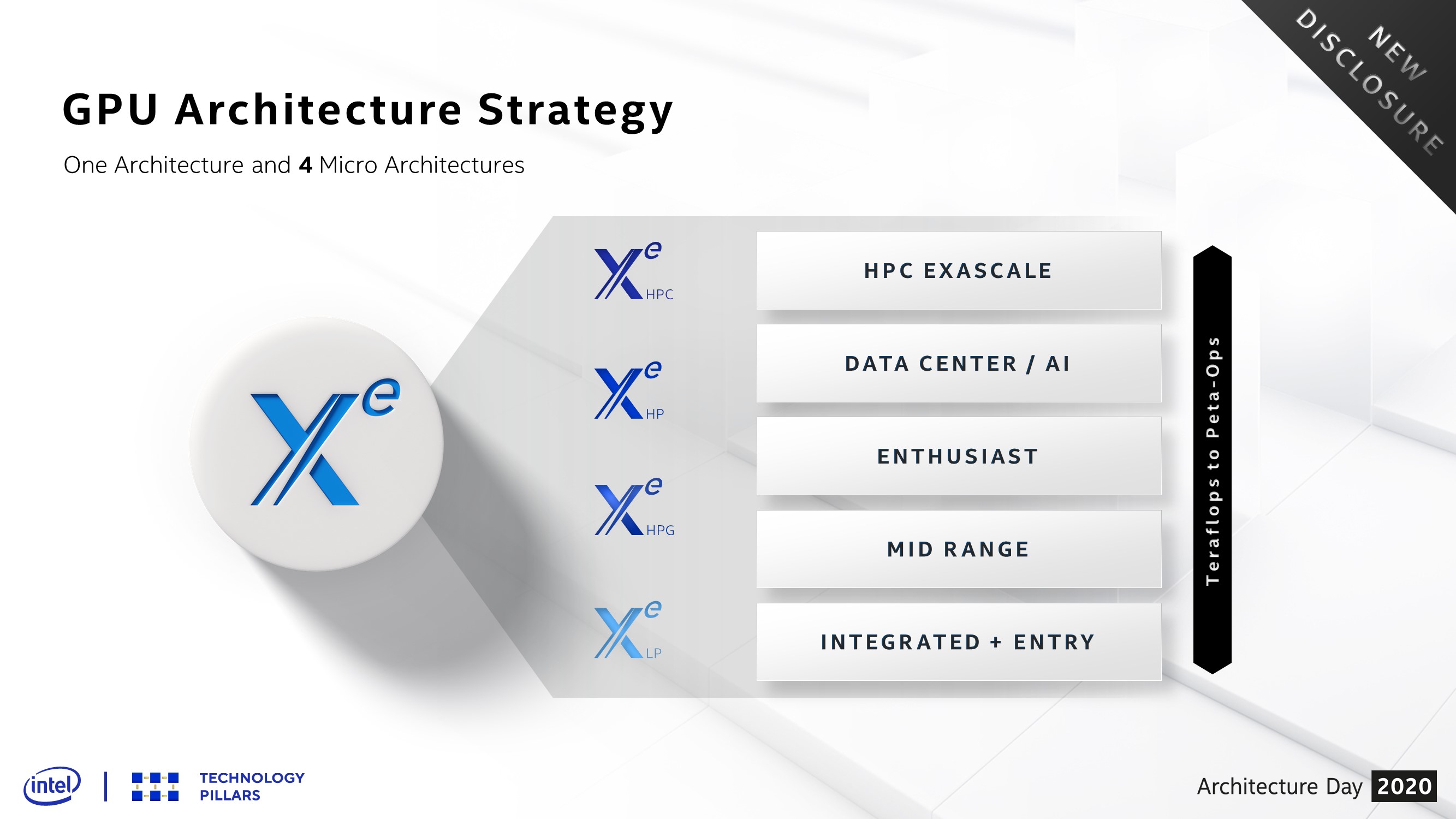During Intel Architecture Day 2020, they made a number of announcements. While a fair amount was marketing talk and plenty for servers, they did give a few details on their upcoming dedicated GPUs.
Intel's new GPU strategy is Xe, a single overall architecture split between four micro-architectures that have various different targets from high-performance servers right down to integrated solutions. They're betting big on it. From what they announced, the one for gamers will be known as Xe-HPG, as they said they "heard your requests for Xe for enthusiast gaming". Xe-HPG is optimized for gaming, it comes with GDDR6 and will provide accelerated Ray Tracing support too. Don't go getting too excited yet though, Xe-HPG is not due until 2021.
Other big news includes their CPUs, as they're coming back to compete against AMD Ryzen, which they've been lagging behind on the tech front for a while now. They're calling their new CPU tech 'SuperFin', which is still 10nm but they say it's a "redefinition of the FinFET with new SuperMIM capacitors that enables the largest single, intranode enhancement in Intel’s history" and it will provide their CPUs with a performance boost comparable to a "full-node transition".
This is for the upcoming Willow Cove CPU architecture and the Tiger Lake platform. A whole lot of marketing speak to mention it will be a "generational leap" for everything from graphics to AI with more memory bandwidth, better security and everything you would expect. Tiger Lake will support Thunderbolt 4, DDR4-3200 and it will also have integrated graphics powered by their shiny new Xe-LP with "up to 96 execution units". Tiger Lake will be a mobile-focused architecture, so expect to see all this new stuff in laptops first. Intel showed a video of the Xe-LP GPU power being compared with Gen11 graphics (Ice Lake) in Battlefield 1 and it was a pretty big improvement.
We're also going to be seeing the Alder Lake architecture, which is their new Hybrid CPU system that pulls together their next-next generation Golden Cove with Grace Mont to create a "performance hybrid". Although they didn't actually give many solid facts on what it will contain other than cores of both.
It's safe to say Intel have a lot of impressive stuff coming and it seems like they will be keeping AMD on their toes. Competition is good for everyone of course.
For the full info you can see their press release here, plus the video and other bits here.
A third player in the GPU market is something the gamers need.
Now We need a third player in the CPU market for gaming computers.
the one for gamers will be known as Xe-HPGCatchy. Still, as the Commandante says, a third player in the market is a Good Thing. The duopoly needs a shake-up.
Last edited by Shmerl on 13 Aug 2020 at 4:52 pm UTC
Finally!
A third player in the GPU market is something the gamers need.
Now We need a third player in the CPU market for gaming computers.
I don't want Nvidia making CPUs
Though there are a few interesting new arm laptops, soon in desktops hopefully, not even to mention Apple new in house arm CPUs.
Finally!
A third player in the GPU market is something the gamers need.
Now We need a third player in the CPU market for gaming computers.
As long as x86 is the dominant architecture there won't be a third player. Intel and AMD are far too ahead and own too many patents. Could you imagine if AMD had completely collapsed a few years back?
Some analysts believe the future of the desktop is in ARM. I'm not so convinced. AMD have proved you can produce a powerful high core cpu with a low power budget, if Intel can get things back on track we will see many more years of x86.
Some analysts believe the future of the desktop is in ARM. I'm not so convinced.
I'm not convinced either. ARM doesn't have anything to offer for the desktop that would make it more attractive than x86_64. That said, I wouldn't mind some new architecture to be available as an alternative to x86_64. But not ARM, especially if it's going to be owned by Nvidia.
Last edited by Shmerl on 13 Aug 2020 at 6:56 pm UTC
Finally!
A third player in the GPU market is something the gamers need.
Now We need a third player in the CPU market for gaming computers.
As long as x86 is the dominant architecture there won't be a third player. Intel and AMD are far too ahead and own too many patents. Could you imagine if AMD had completely collapsed a few years back?
There is a third player. VIA still owns the rights to produce x86 arch CPUs but (afaik) those rights are not transferable by companies purchase and the last CPU I heard from them was released circa 2007 so I really doubt that we will see a new real contender in the x86 market any time soon (Intel will simply not allow it).
IMO, ARM is more than ready for desktop environment the only wall for them is all the legacy software that is only compiled for x86.
Last edited by x_wing on 13 Aug 2020 at 9:08 pm UTC
There is a third player. VIA still owns the rights to produce x86 arch CPUs but (afaik) those rights are not transferable by companies purchase and the last CPU I heard from them was released circa 2007 so I really doubt that we will see a new real contender in the x86 market any time soon (Intel will simply not allow it).
Zhaoxin, a joint venture between VIA and the Shanghai Municipal Government, is developing new x86-64 CPUs.
Their performance is abysmal, and they are for the chinese market, but still...
If the Chinese get serious about local production of such things, they could back that until it gets somewhere. The Chinese understand industrial policy. And they are becoming increasingly wary of letting the US control any technological chokepoints that could disrupt their economy.There is a third player. VIA still owns the rights to produce x86 arch CPUs but (afaik) those rights are not transferable by companies purchase and the last CPU I heard from them was released circa 2007 so I really doubt that we will see a new real contender in the x86 market any time soon (Intel will simply not allow it).
Zhaoxin, a joint venture between VIA and the Shanghai Municipal Government, is developing new x86-64 CPUs.
Their performance is abysmal, and they are for the chinese market, but still...
There's far too much turbulence within Intel to have much faith in this endeavor. This announcement comes at a strange point in time after a long and rocky road that has taken a large toll on the company. Even with their massive wallet, there isn't an infinite amount of resources to pour into this enormously expensive project.
We could definitely benefit from a third contender in the (consumer) discrete GPU market so I hope they'll make something of it... but honestly, I'm not counting on it.
I believe I was watching an AdoredTV video a few months back and it was commented that Raja hadn't started fresh with Xe, but it was something that Intel was already working on that he took a modified the design. It might not be until a few more years when he's had chance to fully develop his own GPU architecture that we see something truly competitive... But I'm open and hopeful to being wrong. It would be nice to see prices drop to where they used to be for GPU's ~12 years ago. Paying $800+ for a high end GPU is pretty obscene as far as I'm concerned.
Some analysts believe the future of the desktop is in ARM. I'm not so convinced.
I'm not convinced either. ARM doesn't have anything to offer for the desktop that would make it more attractive than x86_64. That said, I wouldn't mind some new architecture to be available as an alternative to x86_64. But not ARM, especially if it's going to be owned by Nvidia.
RISC-V is the future. It will topple both ARM and x86 as the dominant architecture. A lot of big names already use it for making their own chips, like Western Digital.
Last edited by Audi on 14 Aug 2020 at 3:03 pm UTC
RISC-V will likely compete with ARM's offerings in the future but toppling x86 isn't certain. To my knowledge no RISC-V designs exist that can reach a parity with ARM's high-end CPUs much less modern x86_64 CPUs. It would be very much welcome if that were to happen though.Some analysts believe the future of the desktop is in ARM. I'm not so convinced.
I'm not convinced either. ARM doesn't have anything to offer for the desktop that would make it more attractive than x86_64. That said, I wouldn't mind some new architecture to be available as an alternative to x86_64. But not ARM, especially if it's going to be owned by Nvidia.
RISC-V is the future. It will topple both ARM and x86 as the dominant architecture. A lot of big names already use it for making their own chips, like Western Digital.
Even better would be if Intel manages to becomes successful in the professional segment with their GPU's. The problem now is that so many professional applications require CUDA. This needs to change, Intel and AMD should join forces on this issue and try to make the market shift to open alternatives.
















 How to set, change and reset your SteamOS / Steam Deck desktop sudo password
How to set, change and reset your SteamOS / Steam Deck desktop sudo password How to set up Decky Loader on Steam Deck / SteamOS for easy plugins
How to set up Decky Loader on Steam Deck / SteamOS for easy plugins
See more from me